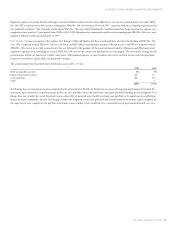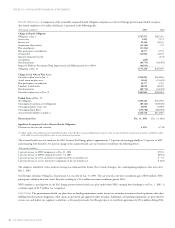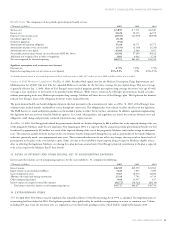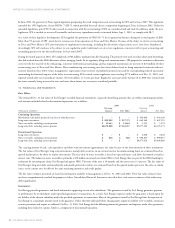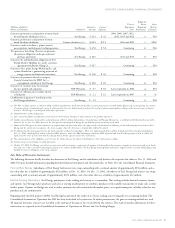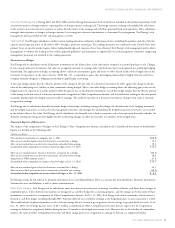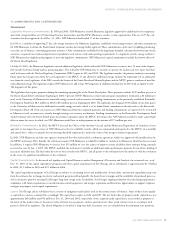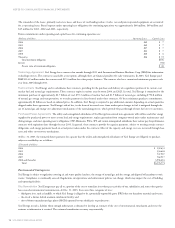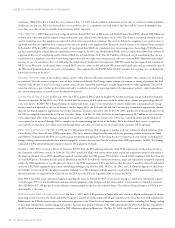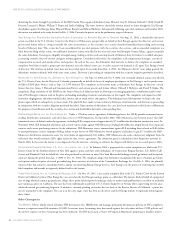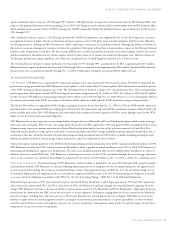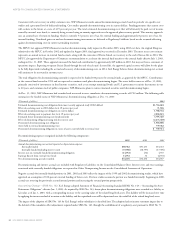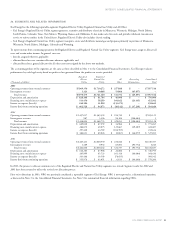Xcel Energy 2003 Annual Report Download - page 61
Download and view the complete annual report
Please find page 61 of the 2003 Xcel Energy annual report below. You can navigate through the pages in the report by either clicking on the pages listed below, or by using the keyword search tool below to find specific information within the annual report.NOTES TO CONSOLIDATED FINANCIAL STATEMENTS
XCEL ENERGY 2003 ANNUAL REPORT 77
To estimate the cost to remediate these sites, assumptions are made when facts are not fully known. For instance, assumptions may be made about the
nature and extent of site contamination, the extent of required cleanup efforts, costs of alternative cleanup methods and pollution-control technologies, the
period over which remediation will be performed and paid for, changes in environmental remediation and pollution-control requirements, the potential
effect of technological improvements, the number and financial strength of other PRPs and the identification of new environmental cleanup sites.
Estimates are revised as facts become known. At Dec. 31, 2003, the liability for the cost of remediating these sites was estimated to be $43.2 million,
of which $12.5 million was considered to be a current liability. Some of the cost of remediation may be recovered from:
–insurance coverage;
–other parties that have contributed to the contamination; and
–customers.
Neither the total remediation cost nor the final method of cost allocation among all PRPs of the unremediated sites has been determined. Estimates
have been recorded for Xcel Energy’s share of future costs for these sites. Management is not aware of other parties’ inability to pay, or responsibility for
any of the sites that is in dispute.
Approximately $10.1 million of the long-term liability and $4.5 million of the current liability relate to a U.S. Department of Energy assessment to
NSP-Minnesota and PSCo for decommissioning a federal uranium enrichment facility. These environmental liabilities do not include accruals recorded
and collected from customers in rates for future nuclear fuel disposal costs or decommissioning costs related to NSP-Minnesota’s nuclear generating
plants. See Note 18 to the Consolidated Financial Statements for further discussion of nuclear obligations.
Ashland MGP Site NSP-Wisconsin was named as one of three PRPs for creosote and coal tar contamination at a site in Ashland, Wis. The Ashland
site includes property owned by NSP-Wisconsin, which was previously an MGP facility, and two other properties: an adjacent city lakeshore park area,
on which an unaffiliated third party previously operated a sawmill, and a small area of Lake Superior’s Chequemegon Bay adjoining the park.
The Wisconsin Department of Natural Resources (WDNR) and NSP-Wisconsin have each developed several estimates of the ultimate cost to remediate
the Ashland site. The estimates vary significantly, between $4.0 million and $93.0 million, because different methods of remediation and different
results are assumed in each. The Environmental Protection Agency (EPA) and WDNR have not yet selected the method of remediation to use at the
site. Until the EPA and the WDNR select a remediation strategy for all operable units at the site and determine the level of responsibility of each PRP,
NSP-Wisconsin’s share of the ultimate cost of remediating the Ashland site is not determinable.
In the interim, NSP-Wisconsin has recorded a liability of $18.5 million for its estimate of its share of the cost of remediating the Ashland site, using
information available to date and reasonably effective remedial methods. NSP-Wisconsin has deferred, as a regulatory asset, the remediation costs
accrued for the Ashland site based on an expectation that the Public Service Commission of Wisconsin (PSCW) will continue to allow NSP-Wisconsin
to recover payments for environmental remediation from its customers. The PSCW has consistently authorized recovery in NSP-Wisconsin rates of all
remediation costs incurred at the Ashland site, and has authorized recovery of similar remediation costs for other Wisconsin utilities. External MGP
remediation costs are subject to deferral in the Wisconsin retail jurisdiction and are reviewed as part of the Wisconsin biennial retail rate case process
for prudence. Once approved by the PSCW, deferred MGP remediation costs, less carrying costs, are historically amortized over four or six years. In
addition, the Wisconsin Supreme Court rendered a ruling that reopens the possibility that NSP-Wisconsin may be able to recover a portion of the
remediation costs from its insurance carriers.
As an interim action, Xcel Energy proposed, and the EPA and WDNR have approved, a coal tar removal and groundwater treatment system for one
area of concern at the site for which NSP-Wisconsin has accepted responsibility. The groundwater treatment system began operating in the fall of 2000.
In 2002, NSP-Wisconsin installed additional monitoring wells in the deep aquifer to better characterize the extent and degree of contaminants in that
aquifer while the coal tar removal system is operational. In 2002, a second interim response action was also implemented. As approved by the WDNR,
this interim response action involved the removal and capping of a seep area in a city park. Surface soils in the area of the seep were contaminated with
tar residues. The interim action also included the diversion and ongoing treatment of groundwater that contributed to the formation of the seep.
On Sept. 5, 2002, the Ashland site was placed on the National Priorities List (NPL). The NPL is intended primarily to guide the EPA in determining which
sites require further investigation. On Nov. 14, 2003, the EPA and NSP-Wisconsin signed an administrative order on consent requiring NSP-Wisconsin
to complete the remedial investigation and feasibility study for the site. Resolution of Ashland remediation issues is not expected until 2006 or 2007.
NSP-Wisconsin continues to work with the WDNR to access state and federal funds to apply to the ultimate remediation cost of the entire site.
Fort Collins Manufactured Gas Plant Site Prior to 1926, Poudre Valley Gas Co., a predecessor of PSCo, operated a manufactured gas plant in Fort
Collins, Colo., not far from the Cache la Poudre River. In 1926, after acquiring the Poudre Valley Gas Co., PSCo shut down the gas site and, years later, sold
most of the property. In the mid-1990s, contamination associated with MGP operations was discovered on the gas plant site, and PSCo paid for a portion
of a partial cleanup. Recently, an oily substance similar to MGP by-products has been discovered in the Cache la Poudre River. The source of this substance
has not yet been identified. PSCo is working with the EPA, the Colorado Department of Public Health and Environment, the current site owner and the
City of Fort Collins (owner of a former landfill property between the river and the plant site) to address the substance found in the river as well as other
environmental issues found on the property. The scope of the investigation has expanded as a result of negotiations with the EPA, and PSCo estimates
that the cost of initial removal and investigation activities will be approximately $1.6 million, although the actual cost will vary depending on site


